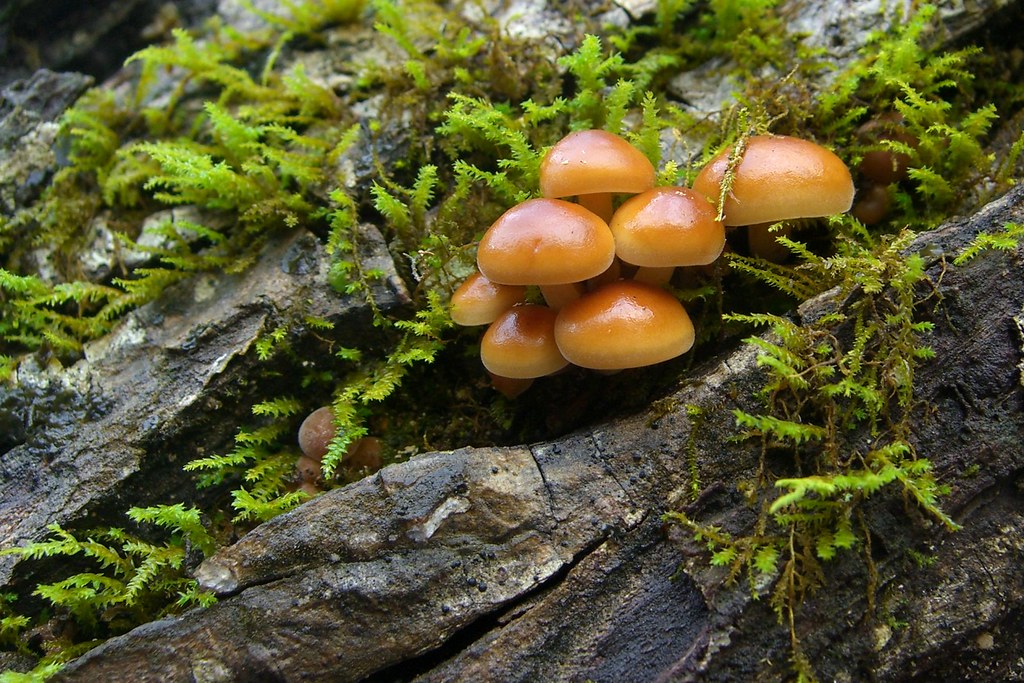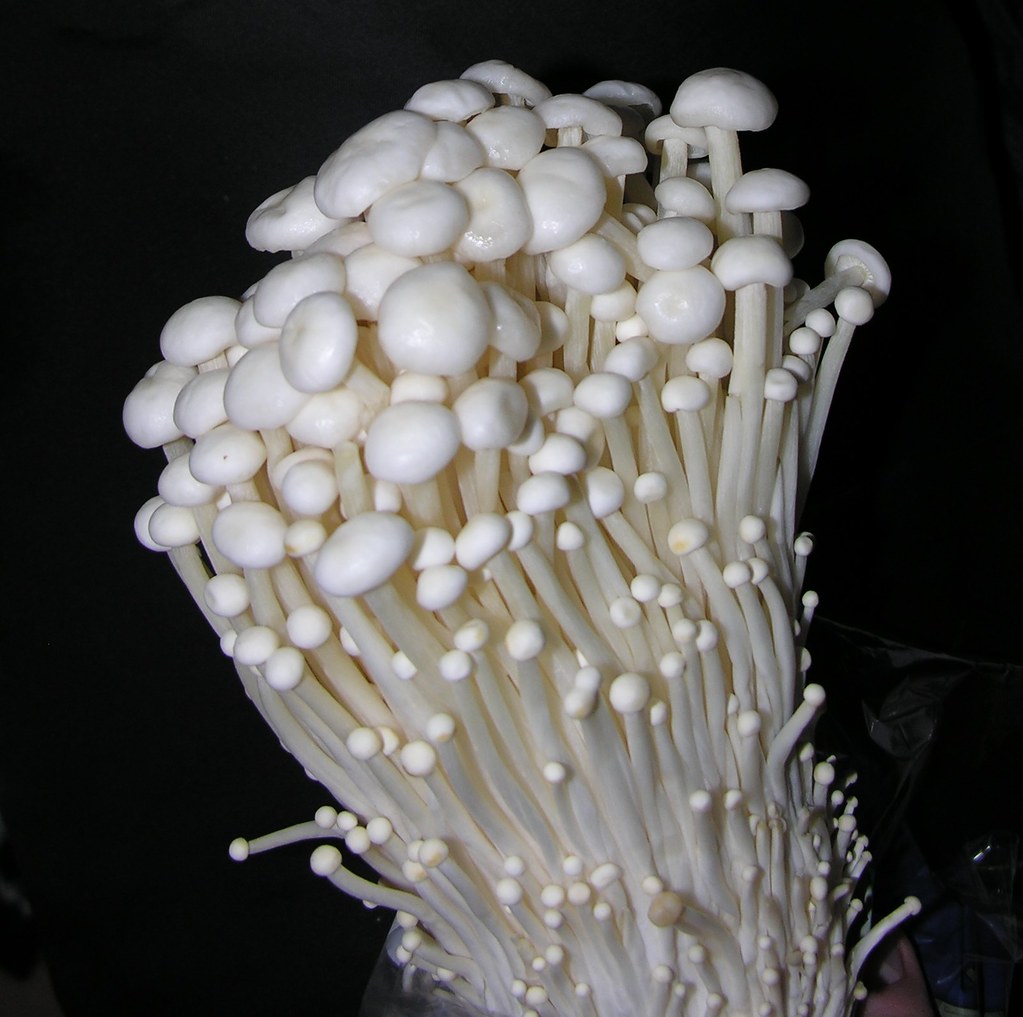Content warning: There is no blood in this post, but there are mushrooms with features that resemble blood droplets.
As I’ve grown in my mushroom identification skills over the years, I have been delighted to find that sometimes I can identify a fungus – to the genus or even species – right away. For example, I correctly identified those yellow mushrooms as being Lactarius specimens before cutting their gills, and my Sulfur Shelf ID holds up years later. But I’m still very much learning and recently had a nice dose of humility.
“Bleeding Tooth fungus”, Hydnellum peckii (hide-nell-um peck-ee-eye), can be a very strange mushroom to stumble upon. It may look like a ‘normal’ white or blush colored mushroom, with a fairly thick stipe and little protrusions like tiny, pointy “teeth” on the underside. The teeth are the spore-bearing surface, which makes this a hydnoid mushroom.

(A longer aside on naming than usual: “hydnoid” means “resembling a hydnum” – go figure – and Hydnum is the name of a genus of mushroom that I suppose was the first “toothy” mushroom group ever made. The word “Hydnum” is a New Latin adaptation of the Greek word “hudnon”, which means “truffle” (1). Truffle mushrooms grow underground and bear their spores internally, not on external toothlike surfaces, so this is where the etymology completely loses me. The species name peckii comes from the last name of a famous mycologist, Charles Horton Peck, who died just five years after this species was discovered and named after him. Peck certainly deserves the honor, as he himself described more than 3000 North American fungi (1).)
So this mushroom looks pretty normal… sometimes. But if you encounter H. peckii after it rains, or in other wet conditions, you will find a mushroom that looks like it has been poked or cut all over the place and started, well, bleeding.

Pretty distinctive looking!
The semi-transparent red blobs result from too much water in the soil forcing its way into the mushroom’s mycelium. As the pressure mounts, the water can be forced out through the surface of the cap (2), picking up pigments on the way – mostly red and orange, but there are black and brown pigments there too. Two of the pigments have yet to be identified and named, though they appear to be additional red and brown coloring agents (3). The act of releasing water droplets from the surface is known as guttation (gut-ay-shun), and while it’s not unique to Hydnellum peckii, or to fungi, no other fungus I know of – or should I say, that I knew of – guttates red.
The point is, when a white fungus is “bleeding”, it seems pretty unlike anything else. It seems like it has to be Hydnellum peckii. So when we found a white, fist-sized lump of fungus with reddish guttation, I said “Ooooh! Bleeding Tooth!” and got to happily snapping pictures of my first wild H. peckii.

Well, class, do we notice anything funny about this supposed Hydnellum specimen?

How about… it isn’t hydnoid!

“I really love my camera,” I commented to Nate at the time. “I’m getting beautiful shots of these pores!” Yes, Izzie, the pores on your “Hydnellum” sample look great.
Okay, it was a long hike. I can forgive myself for not noticing the problem amidst my enthusiasm. But when I sat down to write a blog post about my cool Bleeding Tooth pictures, it registered that something was off. Not only is that definitely a porous surface, I couldn’t find any photos of H. peckii that were shaped even remotely like this one. They’re all cushion-shaped, vaguely round with flat tops. This strange coral- or finger-like growth is absent from any description of Bleeding Tooth.
Alright, fair enough, I’m still learning. So I opened up MycoKey (my installed program, not the limited website version) and tried looking for a club- or coral-shaped mushroom with pores.
And I got lots of coral mushrooms – thin, elegant, tiny corals. But nothing with these big, meaty spires rising up from the substrate, and nothing with obvious external pore structures.

Okay, maybe it would be better to search for the pore surface first, then go with body shape. So I tried searching the polypore key. Nope, all the polypores I found had flat caps coming off the substrate (usually a tree or branch) horizontally. Again, no thick, pointy fingerlike growths.
“Alright,” I thought, “I suppose it’s time to break out a key.” Dichotomous keys ask a series of yes/no questions about your specimen – does it have pores, or not? Is it white/yellow/orange, or not? – to help you narrow down what you’re looking at, or at least give you a genus.
My results made no sense, even when I backtracked and got a little loosey-goosey with some of the characteristics. More polypores with flat caps. Overall, my fruitless search had taken more than an hour. What was going on? I mused to Nate that this could be some weird form of a usually normal-looking polypore that grew under, for example, high-CO2 conditions. The popular edible mushroom Flammulina velutipes, otherwise known as the enoki, grows with large caps in the wild but in captivity is often cultivated under high-CO2 conditions to cause elongation of the stipe and development of a very small cap.


Could something similar have happened to an H. peckii to produce this weird form that seemed to defy identification?
Fortunately, we live in the age of the internet, and I had one last trick up my sleeve: crying for help on a mycology community. I posted my pictures in the Reddit mycology group and waited.

Within twenty minutes I had a suggestion: could this be Abortiporus biennis (a-bort-ih-pour-us by-en-iss)?
Right away I felt something stirring in the universe. Aborti– is a Latin root referring to the stopping of an organism’s normal development. Maybe I was right, and this specimen was indeed an atypical version of a “regular” pored mushroom!
Indeed, Michael Kuo’s description of Abortiporus biennis supports that conclusion: “Two distinct forms of Abortiporus biennis can be encountered: a ‘normal’ looking, regular sort of polypore with a brown cap and a whitish pore surface […] and a gnarled, messy-looking, ‘aborted’ form that consists of a mass of irregular white pores that exude a reddish juice and bruise reddish brown; in this form there is hardly a cap or a stem to speak of…” (4) And while Mr. Kuo’s pictures include nothing quite as extensively finger-like as the form Nate and I saw, there’s definitely some fleshy protrusions with the same pore texture as in my photos.

While he doesn’t have any pictures that look exactly like our specimen, Pat O’Reilly of First Nature also seems to describe what we’re seeing: “This wood-rotting fungus sometimes forms very attractive rosettes […] but more often it grows as an amorphous mass of irregular maze-like pores exuding blobs of red-brown juice…” (5).
Apparently, A. biennis is the “type” (characteristic) mushroom of the genus Abortiporus, which only has three species. The original name of this species, as described way back in 1789, was Boletus biennis, “the pored mushroom that lives for two years” or “the pored mushroom that grows once every two years”. (The word “biennial” or “biannual” has these two very conflicting meanings and I’ve always hated it for that reason). However, the mushroom apparently grows anew every year (5), so the name isn’t appropriate either way. The current genus name comes from a 1944 publication; I have to believe it was renamed after people found enough of the “aborted” forms to want the name to be a little more apt. I suppose they kept the species name for consistency’s sake, since it isn’t really accurate either.
So here I thought I knew what I was doing and instead, once again, I learned about a whole genus I’d never heard of! I certainly don’t consider my time looking for this ID wasted. I explored a lot of keys and learned much more about guttation. Plus, I now have a much more accurate name on my files! Thank you, Abortiporus biennis, for being distinctive enough to catch my eye and send me off on a mycological research adventure.

Sources:
(1) O’Reilly, P. (2021). Hydnellum peckii Banker – Devil’s Tooth. First-Nature.com. First Nature. https://www.first-nature.com/fungi/hydnellum-peckii.php
(2) Fearnley, K. (2016). Weird & Wonderful Creatures: Bleeding Tooth Fungus. AAAS.org. American Association for the Advancement of Science, 4 July 2016. https://www.aaas.org/news/weird-wonderful-creatures-bleeding-tooth-fungus
(3) Deflorin, P. (2012). Spooky Story. Hydnellum peckii, Organismal Biology at University of Wisconsin-La Crosse. http://bioweb.uwlax.edu/bio203/f2012/deflorin_patr/spooky_story.htm
(4) Kuo, M. (2019, October). Abortiporus biennis. Retrieved from the MushroomExpert.Com Web site: http://www.mushroomexpert.com/abortiporus_biennis.html
(5) O’Reilly, P. (2021). Abortiporus biennis (Bull.) Singer – Blushing Rosette. First-Nature.com. First Nature. https://www.first-nature.com/fungi/abortiporus-biennis.php
